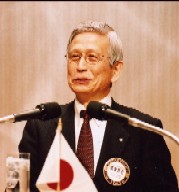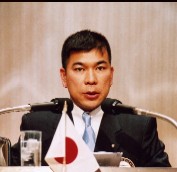Initiation Speech
February 28, 2007
Mr. Katsumaro Chikushi,
Mr. Keitaro Hirose
 ��The Story of Alcoholic Drink��
��The Story of Alcoholic Drink��
Mr. Katsumaro Chikushi,
Managing Director,
Suntory Ltd.
I would like to talk about alcoholic drink, mostly on production of whisky, which is my profession according to the classification of profession at Rotary Club.
In history, something resembling whisky appears in the year 1172.
From records found in England, the report of a vassal of Henry II, who invaded Ireland in 1172 states, ��The residents of this island drink an alcoholic drink which has tastes better than the alcoholic drink in our country and they call it [Uisge-Beatha]��. The name, Uisge-Beatha, means [Water of Life] in Gaelic (Celt language in Ireland) and is a translation of the Latin word, [Aqua-Vitae].
During the days of Henry II, there was no distilled liquor in England and people drank an alcoholic drink made from fermented malt, something like beer. On the other hand, Irish people were drinking distilled liquor. While alcoholic contents of beer is about 6 %, the alcoholic contents of this distilled liquor must have been about 60%, and therefore the soldiers of England found this drink extremely tasty.
The production method of whisky was later transferred from Ireland to England and distilled liquor from wheat was produced. Newly distilled liquor has no color and is clear. The taste of this liquor is very harsh and people drank whisky at this stage. At present, however, we drink whisky with amber color mellowed in barrels. This method of aging in barrels was born by accident.
In 1707, when Scotland was merged with England, taxes on alcoholic drinks were levied. As the Scotch did not want to pay tax on liquor, they moved their distilleries to remote places and transported the liquor to town in barrels at night where they sold them. One day, an illicit distiller sighted a tax collector and hid his barrels in a cave and ran away. A few years later, someone drank the whisky in these barrels and was surprised. The taste was quite different from the harsh taste of clear whisky and it had a mellow taste with amber color. Thus the whisky we drink at present was born.
The process of making whisky is first making sugar from grain and malt. Next, yeast is added to ferment. Then the mash is distilled twice to concentrate the alcohol. In this process, the characteristic process of whisky is the aging in barrels. While whisky before aging does not have any color and the taste is harsh, the aging in barrels for half an year will make it into yellow color and the aging for three to five years will make it into amber color.
Also the flavor will become deeper and more tasteful. For barrels, oak is used and poli-phenol, like lignin and tannin will come out of oak lumber and will work with contents of whisky to make aging. Aging is a ��mysterious drama�� played by oak wood and whisky for a long period of time during aging.
The popular phrase stressing the good effect of alcoholic drinks is ��Alcoholic drink is the best medicine among all the medicines��. This phrase appears in Shokukashi, a Chinese classical document, as ��Alcoholic drink is the best medicine among all the medicines. It is indispensable in a pleasant party.�� These words properly explain the valuable use of alcoholic drinks. Everybody will agree that if you drink proper volume of alcoholic drink, it is very useful, even though there are pros and cons on alcoholic drinking. Therefore there is a proverb ��One cup of alcoholic drink, two cups of tea.�� and if you keep such drinking habit, you will live happily with healthy life.
In Japan, the first whisky was produced at Yamazaki Distillatory in 1923. It has been 84 years since then, and I wish more people will understand and appreciate the attractiveness of whisky.
 ��Uniform Clothing to Protect People��
��Uniform Clothing to Protect People��
Mr. Keitaro Hirose,
President,
Hirose Shokai Co., Ltd.
The rental business of textile products is called as linen supply or uniform rental. ��Uniform Clothing to Protect People��, the title of my speech, is the business model of my business in the future.
In case of the linen supply business for hotels, linen suppliers will purchase sheets, towels and other textile products (so-called linen) and they will lease these products to hotels. After the use of these products at the hotels, suppliers will collect the products from the hotels and clean them at their factory with high temperature cleaning, then supply to the hotels again.
Suppliers will do the repair and exchange, if necessary. Similarly, in the case of uniform rentals, the suppliers will lease the uniforms to the factories, like food factories, then collect the uniforms after the use, clean them and return them to the factories after making sure the quality standard, which is required by factories, by checking each and every uniform.
Linen supply business started in Europe and in the United States, and the Japanese market developed in the 1960s. Before this, each hotel and factory had facilities to do the cleaning at the backyard of railway station, hotels and airport. After the know-how of Europe and United States on linen supply was introduced to Japan, linen supply business developed in cities, taking advantage of space utilization, out-sourcing of management of linen, and cost saving by large scale operation. The linen supply business developed, taking advantage of the increase of hotels at the time of 1964 Tokyo Olympics and 1970 Osaka World Expo.
At present, the line supply business had grown to 550 billion yen business. The major area of the business as of 2005 consists of the following. Dust-control 270 billion yen, hotel linen 80 billion yen, hospital linen 60 billion yen, towel linen 40 billion yen, food linen, like restaurant uniform,30 billion yen, industrial line like factory uniforms 22 billion yen, traffic linen, like airlines and railway ,8 billion yen, diapers 15 billion yen, hand towels 25 billion yen. There are 4,300 companies and 104,000 employees in this business.
The size of the market has decreased 1.6% in the past five years. The growing markets are food linen and industrial linen markets. The dust control market, which used to occupy more than 50% of the market, is in a decreasing trend.
The number of hotels and hotel rooms are increasing about 2% every year. The number of Japanese style inns ��ryokan�� are decreasing after the bubble economy has burst. The reason why the hotels are increasing is due to the nation-wide development of business hotels which specialize in lodging. City hotels are remodeling their facilities and changing to the use of high class linen in order to meet the competition from new hotels of foreign capital. In the city hotel business, linen suppliers must have the capability of proposing an unique plan in order to meet the change of the operating style of the hotels. Linen suppliers must meet this changing situation by choosing a business strategy targeting either a high class customer segment or mass popular class customer segment.
Industrial linen is increasing partly because some factories have returned to Japan from overseas locations. Food and pharmaceutical factories set high sanitary standard in order to avoid quality problems. Factories introduced HACCP, which is the sanitary standard for food of NASA of the United States, and the standard demands high quality, such as design of uniforms to avoid dropping of human hair and the use of high performance materials etc. These HACCP uniforms require cleaning by special line of cleaning, and are managed by using IC chips etc. This is a new business model requiring high know-how.
Lastly, I wish to talk about our future vision. Similar to the situation in which linen business started in Europe and in the United States, the next generation of business model is developing in Europe and in the United States. Because of environmental issues, the return to reuse from disposables is prominent. The example is the return to reusable cloth diapers from paper diapers.
Another example is doctor��s gown and drapes to be used for patients in case of the operation. Reusable products with high bacteria barrier characteristics and comfortable texture are rent to hospitals. These products currently compete against disposable products with non-woven material in the market. The same material is used for the uniform of rescue crew and fire-fighting crew of the fire department. After the use of these uniforms, special cleaning is arranged to maintain the character of the products.
As stated above, to develop and maintain uniforms to protect people who perform important job under severe situation is the future mission of uniform rental business and this is why I stated [Uniform Clothing to protect people] as the title of my speech. Linen supply business matches the spirit of ecology, which is [to respect reuse and not to waste material].
I hope the linen supply business will develop and be recognized by the public as being helpful to the working people and kind to the environment.